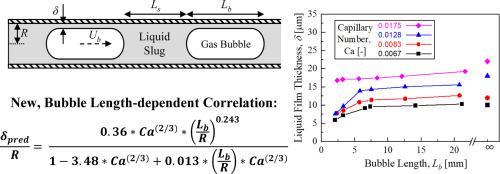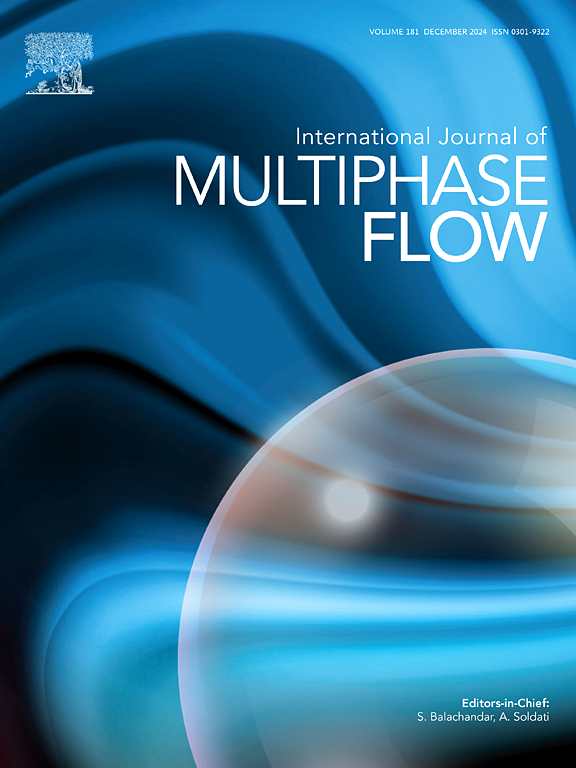微通道段塞流中液膜厚度与气泡长度和速度的关系
IF 3.8
2区 工程技术
Q1 MECHANICS
International Journal of Multiphase Flow
Pub Date : 2025-07-17
DOI:10.1016/j.ijmultiphaseflow.2025.105367
引用次数: 0
摘要
气液两相流动在各种工业过程中都很常见。在毛细管力起重要作用的微尺度通道中,经常观察到以气泡和液体段塞交替流动为特征的段塞流流态。准确了解段塞流过程中气泡周围的液膜厚度对于预测各种流体动力学、界面和热传递特性(如微通道流沸腾过程中的传热)至关重要。在本研究中,我们通过实验和数值研究了单个圆形截面的微通道中气泡长度和速度对气-水段塞流液膜厚度的影响。在实验中,利用开环流动装置在气泡长度和速度独立变化的圆形微通道中产生气-水段塞流。利用激光共聚焦位移计测量液膜厚度,并从高速图像中提取气泡长度和速度。液膜厚度随气泡速度和气泡长度的增加而增加;虽然这种速度的影响已经在文献中报道过,但这是第一次报道气泡长度对液膜厚度的影响。此外,采用两相流体体积法进行了模拟实验边界条件的数值模拟,以证实这一趋势。此外,在给定气泡速度下,随着气泡长度的增加,薄膜厚度渐近接近与文献中先前报道的半无限气泡近似一致的最大值。建立了一种新的经验相关性,它适用于所有气泡长度,并提供了液膜厚度作为无因次气泡长度和无因次毛细管数的函数的准确预测[9%的平均绝对误差(MAE)]。本文章由计算机程序翻译,如有差异,请以英文原文为准。

Correlating liquid film thickness in microchannel slug flow to bubble length and velocity
Two-phase gas-liquid flows are commonly encountered in various industrial processes. The slug flow regime, characterized by alternating streamwise segments of gas bubbles and liquid slugs, is frequently observed in microscale channels where capillary forces play an important role. Accurate knowledge of the liquid film thickness surrounding bubbles during slug flow is crucial for predicting various hydrodynamic, interfacial, and thermal transport characteristics of interest, such as heat transfer during microchannel flow boiling. In this study, we experimentally and numerically investigate the effect of bubble length and velocity on liquid film thickness in an air-water slug flow in a single microchannel of circular cross-section. In the experiments, an open-loop flow facility is used to generate air-water slug flow in a circular microchannel with independently varying bubble lengths and velocities. A laser confocal displacement meter is used to measure the liquid film thickness, while the bubble length and velocity are extracted from high-speed visualizations. The liquid film thickness is observed to increase with increasing bubble velocity and length; while this effect of velocity has been reported in the literature, this is the first reporting of the influence of bubble length on liquid film thickness. Additionally, numerical simulations that replicate the experimental boundary conditions are performed using a two-phase volume-of-fluid approach to corroborate this trend. Furthermore, as the bubble length increases for a given bubble velocity, the film thickness asymptotically approaches a maximum value that agrees with the semi-infinite bubble approximation previously reported in the literature. A new empirical correlation is developed that is valid for all bubble lengths and offers accurate predictions [9 % mean absolute error (MAE)] of the liquid film thickness as a function of the dimensionless bubble length and dimensionless capillary number.
求助全文
通过发布文献求助,成功后即可免费获取论文全文。
去求助
来源期刊
CiteScore
7.30
自引率
10.50%
发文量
244
审稿时长
4 months
期刊介绍:
The International Journal of Multiphase Flow publishes analytical, numerical and experimental articles of lasting interest. The scope of the journal includes all aspects of mass, momentum and energy exchange phenomena among different phases such as occur in disperse flows, gas–liquid and liquid–liquid flows, flows in porous media, boiling, granular flows and others.
The journal publishes full papers, brief communications and conference announcements.

 求助内容:
求助内容: 应助结果提醒方式:
应助结果提醒方式:


